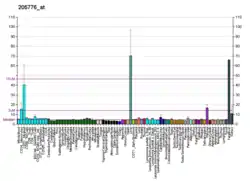| FMO5 | |||||||||||||||||||||||||||||||||||||||||||||||||||
|---|---|---|---|---|---|---|---|---|---|---|---|---|---|---|---|---|---|---|---|---|---|---|---|---|---|---|---|---|---|---|---|---|---|---|---|---|---|---|---|---|---|---|---|---|---|---|---|---|---|---|---|
| Identifiers | |||||||||||||||||||||||||||||||||||||||||||||||||||
| Aliases | FMO5, flavin containing monooxygenase 5, flavin containing dimethylaniline monoxygenase 5, hBVMO1 | ||||||||||||||||||||||||||||||||||||||||||||||||||
| External IDs | OMIM: 603957 MGI: 1310004 HomoloGene: 68185 GeneCards: FMO5 | ||||||||||||||||||||||||||||||||||||||||||||||||||
| |||||||||||||||||||||||||||||||||||||||||||||||||||
| |||||||||||||||||||||||||||||||||||||||||||||||||||
| |||||||||||||||||||||||||||||||||||||||||||||||||||
| |||||||||||||||||||||||||||||||||||||||||||||||||||
| |||||||||||||||||||||||||||||||||||||||||||||||||||
| Wikidata | |||||||||||||||||||||||||||||||||||||||||||||||||||
| |||||||||||||||||||||||||||||||||||||||||||||||||||
Dimethylaniline monooxygenase [N-oxide-forming] 5 is an enzyme that in humans is encoded by the FMO5 gene.[5][6][7]
Metabolic N-oxidation of the diet-derived amino-trimethylamine (TMA) is mediated by flavin-containing monooxygenase and is subject to an inherited FMO3 polymorphism in man resulting in a small subpopulation with reduced TMA N-oxidation capacity resulting in fish odor syndrome Trimethylaminuria. Three forms of the enzyme, FMO1 found in fetal liver, FMO2 found in adult liver, and FMO3 are encoded by genes clustered in the 1q23-q25 region. Flavin-containing monooxygenases are NADPH-dependent flavoenzymes that catalyzes the oxidation of soft nucleophilic heteroatom centers in drugs, pesticides, and xenobiotics.[7]
Related gene problems
References
- 1 2 3 GRCh38: Ensembl release 89: ENSG00000131781 - Ensembl, May 2017
- 1 2 3 GRCm38: Ensembl release 89: ENSMUSG00000028088 - Ensembl, May 2017
- ↑ "Human PubMed Reference:". National Center for Biotechnology Information, U.S. National Library of Medicine.
- ↑ "Mouse PubMed Reference:". National Center for Biotechnology Information, U.S. National Library of Medicine.
- ↑ McCombie RR, Dolphin CT, Povey S, Phillips IR, Shephard EA (Sep 1996). "Localization of human flavin-containing monooxygenase genes FMO2 and FMO5 to chromosome 1q". Genomics. 34 (3): 426–9. doi:10.1006/geno.1996.0308. PMID 8786146.
- ↑ Gelb BD, Zhang J, Cotter PD, Gershin IF, Desnick RJ (Apr 1997). "Physical mapping of the human connexin 40 (GJA5), flavin-containing monooxygenase 5, and natriuretic peptide receptor a genes on 1q21". Genomics. 39 (3): 409–11. doi:10.1006/geno.1996.4516. PMID 9119381.
- 1 2 "Entrez Gene: FMO5 flavin containing monooxygenase 5".
Further reading
- Hines RN, Cashman JR, Philpot RM, et al. (1994). "The mammalian flavin-containing monooxygenases: molecular characterization and regulation of expression". Toxicol. Appl. Pharmacol. 125 (1): 1–6. doi:10.1006/taap.1994.1042. PMID 8128486.
- Phillips IR, Dolphin CT, Clair P, et al. (1995). "The molecular biology of the flavin-containing monooxygenases of man". Chem. Biol. Interact. 96 (1): 17–32. doi:10.1016/0009-2797(94)03580-2. PMID 7720101.
- Overby LH, Buckpitt AR, Lawton MP, et al. (1995). "Characterization of flavin-containing monooxygenase 5 (FMO5) cloned from human and guinea pig: evidence that the unique catalytic properties of FMO5 are not confined to the rabbit ortholog". Arch. Biochem. Biophys. 317 (1): 275–84. doi:10.1006/abbi.1995.1163. PMID 7872795.
- Maruyama K, Sugano S (1994). "Oligo-capping: a simple method to replace the cap structure of eukaryotic mRNAs with oligoribonucleotides". Gene. 138 (1–2): 171–4. doi:10.1016/0378-1119(94)90802-8. PMID 8125298.
- Lawton MP, Cashman JR, Cresteil T, et al. (1994). "A nomenclature for the mammalian flavin-containing monooxygenase gene family based on amino acid sequence identities". Arch. Biochem. Biophys. 308 (1): 254–7. doi:10.1006/abbi.1994.1035. PMID 8311461.
- Overby LH, Carver GC, Philpot RM (1997). "Quantitation and kinetic properties of hepatic microsomal and recombinant flavin-containing monooxygenases 3 and 5 from humans". Chem. Biol. Interact. 106 (1): 29–45. doi:10.1016/S0009-2797(97)00055-0. PMID 9305407.
- Suzuki Y, Yoshitomo-Nakagawa K, Maruyama K, et al. (1997). "Construction and characterization of a full length-enriched and a 5'-end-enriched cDNA library". Gene. 200 (1–2): 149–56. doi:10.1016/S0378-1119(97)00411-3. PMID 9373149.
- Chung WG, Park CS, Roh HK, et al. (2001). "Oxidation of ranitidine by isozymes of flavin-containing monooxygenase and cytochrome P450". Jpn. J. Pharmacol. 84 (2): 213–20. doi:10.1254/jjp.84.213. PMID 11128045.
- Janmohamed A, Dolphin CT, Phillips IR, Shephard EA (2001). "Quantification and cellular localization of expression in human skin of genes encoding flavin-containing monooxygenases and cytochromes P450". Biochem. Pharmacol. 62 (6): 777–86. doi:10.1016/S0006-2952(01)00718-3. PMID 11551524.
- Strausberg RL, Feingold EA, Grouse LH, et al. (2003). "Generation and initial analysis of more than 15,000 full-length human and mouse cDNA sequences". Proc. Natl. Acad. Sci. U.S.A. 99 (26): 16899–903. Bibcode:2002PNAS...9916899M. doi:10.1073/pnas.242603899. PMC 139241. PMID 12477932.
- Krause RJ, Lash LH, Elfarra AA (2003). "Human kidney flavin-containing monooxygenases and their potential roles in cysteine s-conjugate metabolism and nephrotoxicity". J. Pharmacol. Exp. Ther. 304 (1): 185–91. doi:10.1124/jpet.102.042911. PMID 12490590. S2CID 25362483.
- Furnes B, Feng J, Sommer SS, Schlenk D (2003). "Identification of novel variants of the flavin-containing monooxygenase gene family in African Americans". Drug Metab. Dispos. 31 (2): 187–93. doi:10.1124/dmd.31.2.187. PMID 12527699. S2CID 6619389.
- Ota T, Suzuki Y, Nishikawa T, et al. (2004). "Complete sequencing and characterization of 21,243 full-length human cDNAs". Nat. Genet. 36 (1): 40–5. doi:10.1038/ng1285. PMID 14702039.
- Zhang J, Cashman JR (2006). "Quantitative analysis of FMO gene mRNA levels in human tissues". Drug Metab. Dispos. 34 (1): 19–26. doi:10.1124/dmd.105.006171. PMID 16183778. S2CID 1784074.
- Gregory SG, Barlow KF, McLay KE, et al. (2006). "The DNA sequence and biological annotation of human chromosome 1". Nature. 441 (7091): 315–21. Bibcode:2006Natur.441..315G. doi:10.1038/nature04727. PMID 16710414.
This article is issued from Wikipedia. The text is licensed under Creative Commons - Attribution - Sharealike. Additional terms may apply for the media files.





